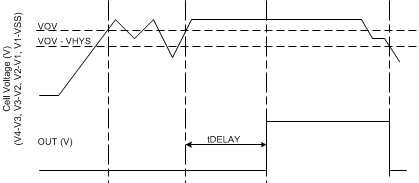SLUSF53 August 2024 BQ2969
PRODUCTION DATA
- 1
- 1 Features
- 2 Applications
- 3 Description
- 4 Device Comparison Table
- 5 Pin Configuration and Functions
- 6 Specifications
- 7 Detailed Description
- 8 Application and Implementation
- 9 Power Supply Recommendations
- 10Layout
- 11Device and Documentation Support
- 12Revision History
- 13Mechanical, Packaging, and Orderable Information
7.3.2 Overvoltage Sensing for OUT
Each cell in the BQ2969 device is monitored independently for an overvoltage condition. Overvoltage is detected by comparing the actual cell voltage to a protection voltage reference, VOV. If any cell voltage exceeds the programmed VOV value, an internal timer circuit is activated. After the timer completes a fixed, pre-programmed delay, the OUT pin transitions from an inactive state to the active state.
 Figure 7-2 Timing for Overvoltage Sensing for OUT
Figure 7-2 Timing for Overvoltage Sensing for OUT